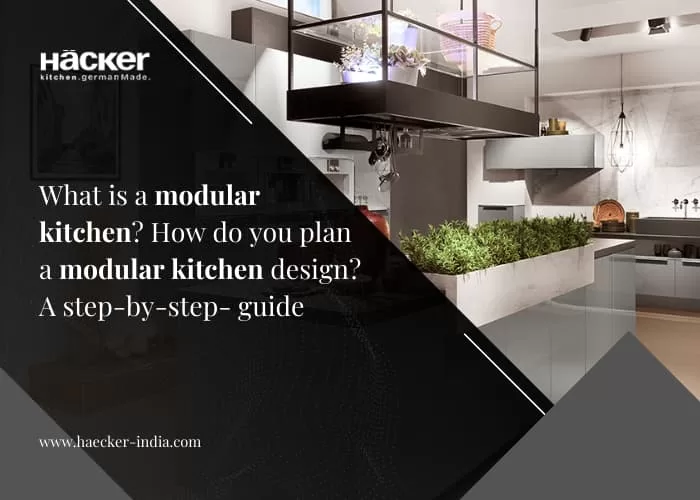A modular kitchen is a popular choice, and the number of homeowners opting for a modular kitchen is steadily on the rise. A modular kitchen is marked by exclusive designs, efficient features, durability, and functionality. A well-designed modular kitchen can be a dream kitchen—something that will enhance the user experience. If you are planning on designing a modular kitchen, then you should understand the modular kitchen concept first.
Learn what a modular kitchen is, and check out this step-by-step guide to designing a modular kitchen.
What is a modular kitchen?
A modular kitchen is composed of individual modules or units that can function independently; these modules are assembled to form a layout that meets the individual client’s requirements. The utilitarian design of a modular kitchen makes the kitchen work easier because these modules are customized as per the kitchen usage pattern and personal style, which enhances the efficiency of the modular kitchen design.
The modular kitchen module style and size are always selected by the end-user to seamlessly fit their kitchen space. A customized modular kitchen design will help with space management and also facilitate the workflow in the kitchen.
The end-user selects the kitchen module materials as per their budget and dominant kitchen theme. Explore the latest modular kitchen designs to select the best design.
What is the purpose of a modular kitchen design?
A modular kitchen design serves not just one but multiple purposes. A modular kitchen has multiple benefits to offer, such as-
- Smart space management: A modular kitchen design is flexible and can fit any space. A well-designed modular kitchen with its customized layout, cabinets, and accessories will optimize the available space.
- Easy cleaning: A modular kitchen consists of detachable kitchen modules and can be easily taken out and thoroughly cleaned.
- Efficient design: The efficient design of the modular kitchens enhances the functionality of the kitchen space.
- Accessibility: Accessibility is another pro that modular kitchens boast of.
How do I design a modular kitchen?
A modular kitchen design is efficient, but its efficiency depends on the design process. While designing a modular kitchen, one must consider every single aspect of the kitchen design carefully. Here are some steps that you must follow if you are planning on designing a modular kitchen.
- Start with the layout: A layout is the arrangement of kitchen modules and appliances. Selecting the right layout holds the secret to kitchen functionality. While designing a modular kitchen, you must choose from the following layouts:
-L Shape
-U Shape
-Single Wall
-Peninsula Kitchen
-Island Kitchen.
Each layout serves a specific purpose, has distinct features, and is ideal for different kitchen sizes. Therefore, you must keep your kitchen requirements, size, and shape in mind while selecting a layout.
- Implement the ‘triangle’: The ‘work triangle’ rule is essential to kitchen functionality. It promotes a smooth workflow in the kitchen and makes it easier for the user to access the three vital points: the cooktop, the refrigerator, and the sink. After determining how much room you have in the kitchen, carefully arrange the three parts to create the hypothetical triangle. Ensure the triangle placement does not obstruct the workflow or the pathway. The kitchen triangle must facilitate accessibility.
- Kitchen storage: Storage planning is not taken seriously, but you must prioritize storage planning to enhance kitchen functionality. An adequate amount of storage will reduce clutter while boosting accessibility, and everything will remain organized. You may select cabinets or the latest kitchen drawers that are stylish and efficient. There are multiple options available for kitchen storage, such as open shelves. It is necessary to explore all available storage module styles and options and carefully select the ones that fit your kitchen space and serve your needs best.
- Kitchen material selection: Select the materials for kitchen modules and worktops carefully. Explore the modular kitchen materials available and learn about their properties, features, and pricing. Do not compromise quality because of price; keep durability and maintenance in mind. Conduct some research to learn about durable materials that are easy to clean. The materials should also remain flawless despite years of usage. Talk to a modular kitchen dealer and learn about material options that seamlessly fit your requirements and style.
- Select your appliances. You should not select the kitchen appliances randomly. Keep your usage pattern and requirements in mind before appliance selection. The kitchen appliances should not sit idly; the appliances should be a part of your daily kitchen activities or at least they should be frequently used. Select energy-efficient appliances from the best brands.
A modular kitchen is a better option than a regular kitchen design in terms of quality, functionality, durability, and aesthetics. However, designing a modular kitchen takes a lot of planning and strategizing. The steps discussed here outline the basic design requirements to help you design a perfect modular kitchen. Keep them in mind and reach out to the best modular kitchen brand.


